
This e-book, which has been translated into English, sets out the carbon, water and ecological footprints of foods and culinary preparations (items composed of more than one ingredient) consumed in Brazil.
Publisher’s summary
This book presents a table with carbon, water and ecological footprints of foods and culinary preparations consumed in Brazil, a tool developed to enable the studies of a thesis named The food and its environmental impacts: approaches of national food guides and study of Brazilians diet , which was presented at the Global Health and Sustainability PhD Program of the Faculty of Public Health of the University of São Paulo. The book differs from the thesis by including an additional indicator (the ecological footprint), a different format to display the tables, and the description of basic concepts and methodological processes, which may encourage the researchers that will study the field of environmental impact assessment of foods, based on IBGE’s Household Budget Survey. Publishing the table of environmental footprints means facilitating the execution of integrated health, food and environmental studies. We sought to explain in a simple and objective way the nutritional aspects for those who are active in the environmental area and the environmental aspects for those who are nutrition researchers, facilitating the communication and arrangements for interdisciplinary work.
Reference
Garzillo, J. M. F., Machado, P. P., Louzada, M. L. d. C., Levy, R. B. and Monteiro, C. A. (2019). Footprints of foods and culinary preparations consumed in Brazil. Universidade de São Paulo, Faculdade de Saúde Pública, São Paulo.
Read more here. See also the Foodsource building block What is ultra-processed food? And why do people disagree about its utility as a concept?







Post a new comment »